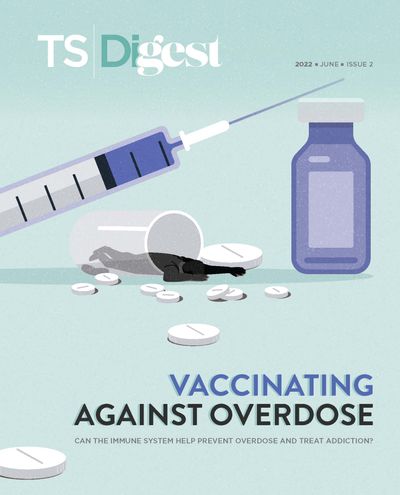ABOVE: © catherine delphia
Due to their small molecular size, opioids can cross the blood-brain barrier (BBB) to cause both the euphoria that makes such drugs so addictive and the adverse effects including the respiratory depression that can cause fatal overdose via inhibition of neural networks that regulate breathing (left panel). To fight opioid use disorder (OUD) and reduce overdose deaths, scientists have designed a handful of experimental vaccines, which are just beginning to enter human testing. These experimental vaccines involve a carrier protein studded with analogs of the opioid, called haptens, combined with adjuvants that strengthen the overall immune response (middle panel). Antibodies generated against haptens will bind to the opioid, blocking it from crossing the BBB due to the antibodies’ large size (right panel). The hope is that if people recovering from OUD receive a vaccine targeting their drug of abuse and then relapse, they will not experience respiratory depression that can lead to overdose or the euphoric effects that reinforce the drug-seeking behavior.

Approved Drugs for Opioid Use Disorder
While it may seem counterintuitive, some drugs used to treat opioid use disorder (OUD) activate opioid receptors in the brain. Methadone is a full opioid agonist, binding to and activating opioid receptors while blocking the binding of other opioids. It is longer-acting than opioids such as heroin and oxycodone, however, so it can provide a mild, controlled “hit” to reduce withdrawal symptoms such as drug craving, gastrointestinal distress, and accelerated heart rate. Another OUD treatment approved in the US is buprenorphine, a partial opioid agonist that binds to but only partially activates the receptor. A third option, naltrexone, is an opioid antagonist, meaning that it blocks opioids from binding the receptors without any activation. In addition, the overdose antidote naloxone can be used to treat overdose itself. It is an opioid antagonist that knocks opioid molecules off the opioid receptors and takes their place.

Drugs for OUD | Drug for reversing overdose | ||
Methadone Binds and fully activates | Buprenorphine Binds and partially activates | Naltrexone Binds but doesn’t activate | Naloxone Knocks opioid off receptors |
Read the full story.
Membership Open House!
Enjoy OPEN access to Premium Content for a limited timeInterested in exclusive access to more premium content?




